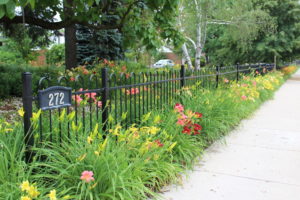The Problems with Traditional Turf Landscapes
Quiet Nature started out in 1999 based on the concept of replacing front yard lawns with low-maintenance, sustainable and beneficial alternatives. We still perform this service for numerous customers through Waterloo Region and the surrounding areas each and every year.
Turf grass has long been a popular choice for landscaping, especially in residential yards. It provides a soft, green surface for recreation, and creates a manicured look that is often considered attractive. However, traditional turf landscapes come with a number of problems that make them unsustainable and environmentally damaging.
Water Consumption
One of the biggest problems with traditional turf grass is the amount of water it requires. Turf grass typically needs to be watered regularly in order to stay green and healthy, especially in hot and dry climates. This can be a significant drain on local water resources, especially in areas that are prone to drought. In addition, the water used to irrigate turf grass is often treated with fertilizers and other chemicals that can end up contaminating waterways and harming aquatic life.
Environmental Impact
In addition to consuming large amounts of water, traditional turf grass also has a number of other negative environmental impacts. For one, it requires a lot of energy to produce and maintain. Lawnmowers, leaf blowers, and other power tools are often used to keep turf grass looking neat and tidy, and these tools produce emissions that contribute to air pollution. In addition, the chemicals used to treat turf grass can be harmful to the environment. Fertilizers, pesticides, and herbicides can all end up in the soil and water, where they can have detrimental effects on plants, animals, and people.
Sustainable Alternatives
Fortunately, there are a number of sustainable alternatives to traditional turf grass that can be used in landscaping. Quiet Nature has been installing these types of landscapes for many years. These options offer a number of benefits over traditional turf, including reduced water consumption, less maintenance, and a smaller environmental footprint. Here are a few examples:
Native Plants
One of the most sustainable alternatives to traditional turf is the use of native plants in landscaping. Native plants are those that are naturally found in a particular region, and they are adapted to the local climate and soil conditions. As a result, they require less water and maintenance than non-native plants, and they often support a wider range of wildlife. In addition, native plants can help to preserve the local ecosystem, as they are an important part of the food chain for birds, butterflies, and other animals.
Xeriscaping
Another sustainable alternative to traditional turf is xeriscaping, which involves the use of drought-tolerant plants in landscaping. Xeriscaping is especially well-suited to arid regions, where water is scarce, but it can be used in any location to conserve water. Xeriscaped landscapes typically use a combination of native plants, rock gardens, and mulch to create an attractive and sustainable yard.

Groundcover Plantings
Groundcover plantings are another sustainable alternative to traditional turf grass. These plantings consist of low-growing plants that spread out over the ground, covering it with a carpet of green. Groundcover plantings have a number of benefits over traditional turf, including:
Reduced water consumption: Many groundcover plants are drought-tolerant and require minimal watering, making them a more sustainable choice for areas that are prone to drought.
Low maintenance: Groundcover plantings require minimal maintenance, as they do not need to be mowed or trimmed like traditional turf. This makes them an attractive option for people who want a low-maintenance yard.
Environmental benefits: Groundcover plantings can help to reduce erosion, as the roots of the plants help to hold the soil in place. In addition, many groundcover plants are native to a particular region, which means they can help to preserve the local ecosystem and support a wide range of wildlife.
There are many different types of groundcover plants to choose from, including creeping juniper, creeping phlox, and thyme. It is important to choose plants that are well-suited to the local climate and soil conditions, as this will help to ensure that they thrive and provide the desired groundcover.
Groundcover plantings can be used in a variety of landscaping applications, including covering bare areas of the yard, filling in between stepping stones, and creating a border around the edge of a garden bed. They can be combined with other sustainable landscaping elements, such as native plants and xeriscaped areas, to create a diverse and attractive yard that is environmentally friendly.
Stone or Aggregate Groundcover
Stone or aggregate groundcover is another sustainable alternative to traditional turf grass. These groundcovers are made from materials such as gravel, crushed stone, or recycled materials, and they can be used to create a hard-wearing and attractive surface in a variety of landscaping applications.
One of the main benefits of stone or aggregate groundcover is its low water consumption. Unlike traditional turf grass, which requires regular watering to stay green, stone or aggregate groundcover requires virtually no water. This makes it a good choice for areas that are prone to drought, or for people who want to reduce their water usage.
In addition to its low water consumption, stone or aggregate groundcover has a number of other benefits. It is low maintenance, as it does not need to be mowed or trimmed like traditional turf. It is also durable and long-lasting, making it a good choice for areas that experience heavy foot traffic. In addition, stone or aggregate groundcover can be used to create a variety of different looks, from a formal, structured garden to a natural, rustic landscape.
There are many different types of stone or aggregate groundcover to choose from, including pea gravel, crushed granite, and recycled rubber. It is important to choose a material that is well-suited to the local climate and the intended use of the area. For example, pea gravel may not be the best choice for a high-traffic area, as it can be prone to compaction and erosion, while crushed granite is more durable and can withstand heavy use.
Stone or aggregate groundcover can be used in a variety of landscaping applications, including pathways, patios, and driveways. It can be combined with other sustainable landscaping elements, such as native plants and xeriscaped areas, to create a diverse and attractive yard that is environmentally friendly.
If you’d like help with the design and/or installation of your sustainable landscape, please contact us at Quiet Nature and we’d be happy to assist.
